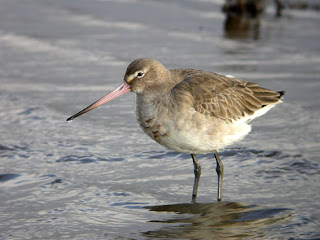
Further to the comment about the lack of new postings recently and as Tony indicated, all three key partners have been taking a bit of (.......we hope you'll agree) well earned holiday last week.
I was in County Clare on the west coast of Eire where I came across peregrines on three occasions during the week, flying and in one case hunting over estuaries and coastal shores. It's always great to see them in such remote settings!
When I was a very novice bird watcher back in the 1960s, when DDT and dieldrin were doing their best to wipe them out completely, there were no peregrines in England at all. To locate one, you had to travel to somewhere like the west coast of Ireland or NW Scotland. I saw my first peregrine on Cape Clear, a remote island off the SW tip of Eire, way back in 1962. (That tells you just how long in the tooth I am!)
When I was a very novice bird watcher back in the 1960s, when DDT and dieldrin were doing their best to wipe them out completely, there were no peregrines in England at all. To locate one, you had to travel to somewhere like the west coast of Ireland or NW Scotland. I saw my first peregrine on Cape Clear, a remote island off the SW tip of Eire, way back in 1962. (That tells you just how long in the tooth I am!)
On getting back home this time, I made a quick trip down to the cathedral last Monday morning to check for prey remains and to see if there were any birds around. The female was on the gargoyle above the nest and I found old remains of lapwing and snipe, two commonly caught species, under the cathedral walls.
I have also caught up with my local hobbies which have now just fledged three youngsters, two months after the young peregrines fledged! I gather from the local hobby enthusiasts that, out of 23 nests visited this summer, seven (ie almost a third) have failed, the highest failure rate ever recorded by them in some 20 years of study...and all down to the awful summer weather.
The wonderful photo of a hobby is by John Miller, to whom many thanks for permission to publish it (and it IS the right way up incidentally!) To see the original post about hobbies (and another brilliant John Miller photo) go back to the blog on 31st July.
Blog fatigue....
Blog fatigue....
We do hope to keep the blog going over the autumn but please be aware that there is less (or maybe nothing) to report now the breeding season is well and truly over, so finding things to write about gets harder without straying too far off topic! A little patience on your parts may therefore be required.
Of course, you could probably encourage us to post more often if you chose to send in some more donations to support the project's future? While we have had 3 - 4 generous donations totalling over £100 from keen (one might even say 'some of our more fanatical') blog and web cam followers , some others who indicated a willingness to donate have yet to do so.....forgive me mentioning it again. Contact the Trust via enquiries@derbyshirewt.co.uk for details of how to donate should you wish to send us some further encouragement!
Nick B


 May we repeat an alert made in the last entry to the effect that this blog has suddenly started suffering attacks of automated spamming. Fairly inoccuous looking comments are starting to be left to numerous archived entries. These contain hyperlinks to inappropriate websites. We will review the situation and hope that Blogger itself may be able to prevent this. It may not last but, should it get too bad, we may be forced to reinstate comment moderation, which would be a shame. We hope you will understand.
May we repeat an alert made in the last entry to the effect that this blog has suddenly started suffering attacks of automated spamming. Fairly inoccuous looking comments are starting to be left to numerous archived entries. These contain hyperlinks to inappropriate websites. We will review the situation and hope that Blogger itself may be able to prevent this. It may not last but, should it get too bad, we may be forced to reinstate comment moderation, which would be a shame. We hope you will understand. 











